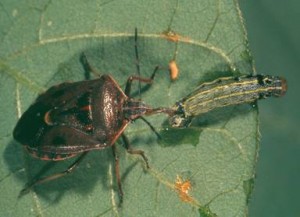Insect predators consume several-to-many prey over the course of their development. They are free living, and are usually as big as or bigger than their prey. Predators may be generalists, feeding on a wide variety of prey, or specialists, feeding on only one or a few closely related species.
Characteristics of predators
- Generally larger than their prey
- Consume many prey
- All life stages can be predatory (immature and adult)
- Can be transient (ladybirds) or residential (predatory mites)
- Use different approaches to find and kill prey e.g. actively searching or waiting for prey
- Modified body parts to assist predatory movement e.g. well developed mouthparts
Benefits of predators
- They often attack different life stages of the pest, and even different pest species.
- Many predators are also able to supplement their diet by feeding on alternative food sources, such as nectar, pollen and fungi.
- They are often voracious feeders and more robust than parasites.
Limitations of predators
- They usually require higher populations of their prey to work effectively and once they have ‘cleaned them up’ may disappear from the scene.
- It is often difficult to show the impact of predators due to the difficulty in isolating their action among a complex of natural control factors in field situations.
Feeding Habits of predators
Predators may be categorized based on feeding mechanisms:
- Those with chewing mouth parts which simply chew up and swallow their victims. This includes ladybugs, ground beetles and preying mantis
- Those with piercing-sucking mouthparts which stick the mouthpart into the prey and suck out the body contents. These predators often have powerful toxins and digestive enzymes that immobilize the prey. This group includes the assassin bugs, lacewing larvae, and true bugs.

Glossy shield bug adult
Main predator groups:
- spiders
- predatory bugs
- predatory mites
- lacewings
- beetles
- hoverflies
To improve the abundance and diversity of beneficial insects – consider native vegetation on the farm as a part of a pest management strategy.

